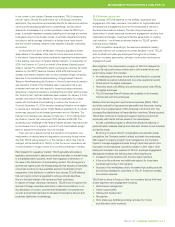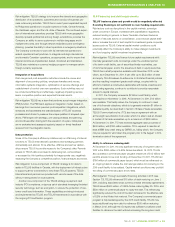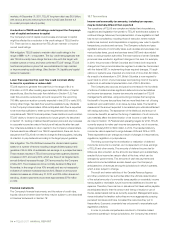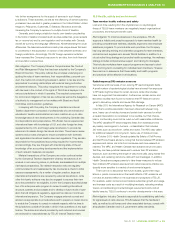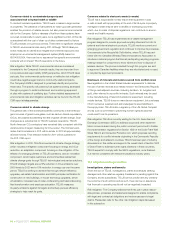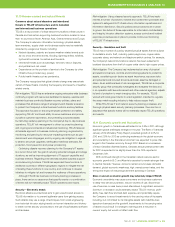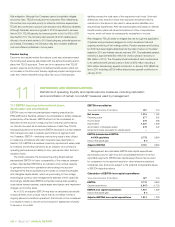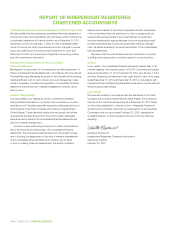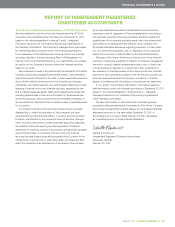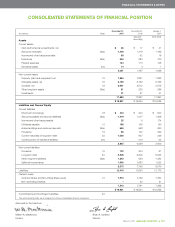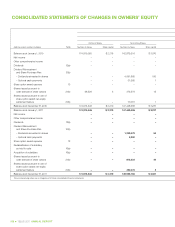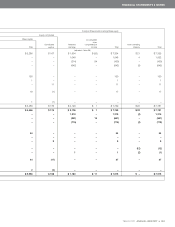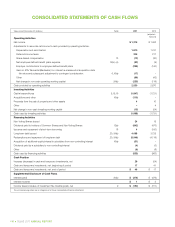Telus 2011 Annual Report Download - page 104
Download and view the complete annual report
Please find page 104 of the 2011 Telus annual report below. You can navigate through the pages in the report by either clicking on the pages listed below, or by using the keyword search tool below to find specific information within the annual report.
10 0 . TELUS 2011 ANNUAL REPORT
Risk mitigation: Although the Company cannot completely mitigate
economic risks, TELUS introduced the Customers First initiatives as
the number one corporate priority to enhance customer experiences.
TELUS
also continues to pursue cost reduction and efficiency initiatives.
Although Canadian economic growth in 2012 is expected to be lower
than in 2011, TELUS expects its revenue growth to be 3 to 6% in 2012
(see Section 1.5). The Company also expects its 2012 capital expen-
ditures to be at a level similar to 2011 (excluding any potential spectrum
purchases). If necessary, the Company may also consider additional
cost and efficiency initiatives in future years.
Pension funding
Economic and capital market fluctuations could also adversely impact
the funding and expense associated with the defined benefit pension
plans that TELUS sponsors. There can be no assurance that TELUS’
pension expense and funding of its defined benefit pension plans will
not increase in the future and thereby negatively impact earnings and/or
cash flow. Defined benefit funding risks may occur if total pension
liabilities exceed the total value of the respective trust funds. Unfunded
differences may arise from lower than expected investment returns,
reductions in the discount rate used to value pension liabilities, and
actuarial loss experiences. After-tax actuarial gains and losses on defined
benefit pension plans will cause fluctuations in Other comprehensive
income, which will never be subsequently reclassified to income.
Risk mitigation: TELUS seeks to mitigate this risk through the application
of policies and procedures designed to control investment risk and
ongoing monitoring of its funding position. Pension expense and funding
for 2012 have been largely determined by the rates of return on the plans’
assets for 2011 and interest rates at year-end 2011. The estimated pension
recovery is approximately $12 million for 2012 (a pension recovery of
$34 million in 2011). The Company’s best estimate of cash contribu tions
to its defined benefit pension plans in 2012 is $172 million including a
$100 million discretionary special contribution in January 2012 ($298 mil-
lion in 2011 including a $200 million discretionary special contribution in
January 2011).
11.1 EBITDA (earnings before interest, taxes,
depreciation and amortization)
EBITDA does not have any standardized meaning prescribed by
IFRS-IASB and is therefore unlikely to be comparable to similar measures
presented by other issuers. EBITDA should not be considered an
alterna tive to Net income in measuring the Company’s performance,
nor should it be used as an exclusive measure of cash flow. TELUS
has issued guidance on and reports EBITDA because it is a key measure
that management uses to evaluate performance of segments and
the Company. EBITDA – excluding restructuring costs is also utilized
in measuring compliance with debt covenants (see description in
Section 11.4). EBITDA is a measure commonly reported and widely used
by investors and lending institutions as an indicator of a company’s
operating performance and ability to incur and service debt, and as a
valuation metric.
The CICA’s Canadian Performance Reporting Board defined
standardized EBITDA to foster comparability of the measure between
entities. Standardized EBITDA is an indication of an entity’s capacity
to generate income from operations before taking into account
management’s financing decisions and costs of consuming tangible
and intangible capital assets, which vary according to their vintage,
technological currency and management’s estimate of their useful life.
Accordingly, standardized EBITDA comprises revenue less operating
costs before interest expense, capital asset amortization and impairment
charges, and income taxes.
As in 2011, an adjusted EBITDA may also be calculated periodically
to exclude items of an unusual nature that do not reflect normal or
ongoing telecommunications operations, that should not be considered
in a valuation metric or should not be included in assessment of ability
to service or incur debt.
EBITDA reconciliation
Years ended December 31 ($ millions) 2 0 11 2010
Net income 1,215 1,052
Financing costs 377 522
Income taxes 376 335
Depreciation 1,331 1,339
Amortization of intangible assets 479 402
Impairment losses (reversals) for capital assets – –
EBITDA (standardized EBITDA
in CICA guideline) 3,778 3,650
Deduct Transactel gain (17) –
Adjusted EBITDA 3,761 3,650
Management also calculates EBITDA less capital expenditures
as a simple proxy for cash flow at a consolidated level and in its two
reportable segments. EBITDA less capital expenditures may be used
for compa rison to the reported results for other telecommunications
companies over time and is subject to the potential comparability issues
of EBITDA described above.
Calculation of EBITDA less capital expenditures
Years ended December 31 ($ millions) 2 0 11 2010
EBITDA 3,778 3,650
Capital expenditures (1,847) (1,721)
EBITDA less capital expenditures 1,931 1,929
Deduct Transactel gain (17) –
Adjusted EBITDA less capital expenditures 1,914 1,929
11 DEFINITIONS AND RECONCILIATIONS
Definitions of operating, liquidity and capital resource measures, including calculation
and reconciliation of certain non-GAAP measures used by management



